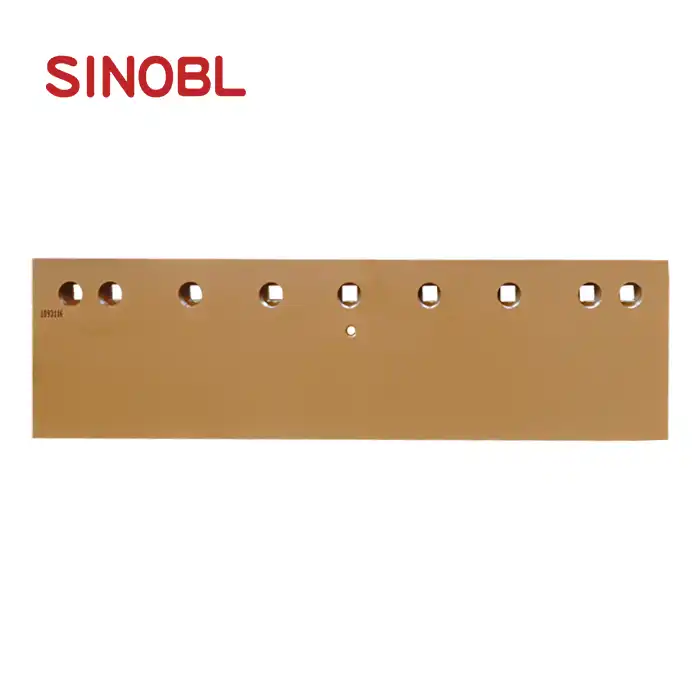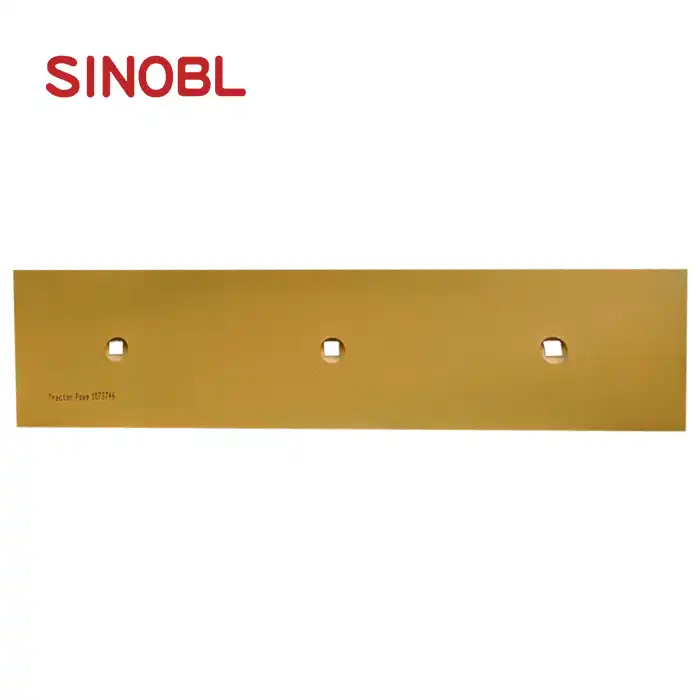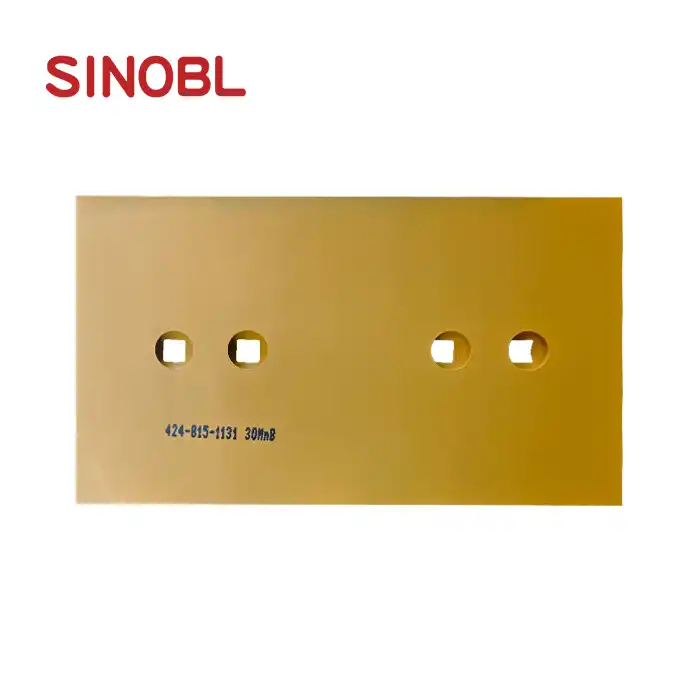What is the weight of the 5D9554 blade?
When it comes to heavy machinery components, precise specifications are crucial for proper equipment operation and maintenance planning. The Grader Blade 5D9554 manufactured by Shanghai Sinobl Precision Machinery Co., Ltd. has a unit weight of 34.2 kilograms (75.4 pounds). This high-performance grader blade is designed for optimal material flow and durability, making it an essential component for construction and road maintenance professionals seeking reliable, long-lasting wear parts. Understanding the weight of the 5D9554 is important for load calculations, transportation logistics, and proper installation procedures when maintaining or upgrading your equipment.
Technical Specifications and Weight Considerations of Grader Blade
Material Composition and Weight Relationship
The Blade 5D9554 weighs 34.2 kilograms due to its robust construction using premium high carbon steel and heat-treated boron steel. This material selection is not arbitrary – it directly influences both the weight and performance characteristics of the blade. The specialized steel alloys used in the Grader Blade 5D9554 undergo rigorous material testing to ensure optimal carbon content, which contributes to the blade's ideal weight-to-strength ratio. Shanghai Sinobl Precision Machinery Co., Ltd. has perfected this formula through years of research and development, resulting in a grader blade that balances weight with exceptional durability. The heat treatment process applied to the Grader Blade 5D9554 further enhances its hardness while maintaining the necessary flexibility to withstand impact stresses. This careful manufacturing approach ensures that every kilogram of the blade's 34.2 kg weight serves a specific purpose in maximizing operational efficiency and service life.
Dimensional Analysis and Weight Distribution
The Blade 5D9554's weight corresponds perfectly to its precise dimensions of 16×152.4×2133.6 mm. These proportions have been engineered to ensure even weight distribution across the entire blade surface, preventing stress concentration that could lead to premature failure. The uniform thickness of 16 mm contributes significantly to the total weight of 34.2 kg while providing sufficient material for wear resistance without unnecessary bulk. The width dimension of 152.4 mm (6 inches) is optimized for compatibility with standard grader models while maintaining structural integrity. At 2133.6 mm (84 inches) in length, the Grader Blade 5D9554 offers extensive coverage for efficient material movement while keeping the weight manageable for handling and installation. SINOBL's engineering team has carefully calculated these dimensions to achieve the ideal weight-to-coverage ratio, maximizing efficiency while minimizing strain on the grader's hydraulic systems and chassis components.
Performance Impact of 34.2 KG Weight
The 34.2 kg weight of the 5D9554 has been precisely engineered to enhance performance across multiple operational parameters. This specific weight provides the optimal downward pressure needed for effective material cutting and movement without overburdening the machine's hydraulic systems. The carefully calculated mass of the Blade contributes to operational stability by helping maintain proper machine balance and ground contact during grading operations. When operating at typical working speeds, the blade's 34.2 kg weight helps dampen vibrations that could otherwise compromise precision and operator comfort. Additionally, the weight-to-strength ratio has been optimized through SINOBL's proprietary heat treatment process, ensuring that the blade maintains its integrity even under extreme pressure and abrasive conditions. Users consistently report that the Grader 's weight provides the perfect balance between maneuverability and cutting power, allowing for precise control in diverse applications from road maintenance to mining operations.
Applications and Operational Benefits of the 34.2 KG Grader Blade 5D9554
Heavy-Duty Construction Applications
The 34.2 kg 5D9554 excels in heavy-duty construction environments where durability and performance are non-negotiable requirements. Road construction crews rely on this precisely weighted blade for creating smooth, even surfaces that meet stringent quality standards. The blade's optimized weight provides sufficient downward force to effectively cut through compacted materials while maintaining the maneuverability needed for precise grading work. In foundation preparation projects, the Blade's 34.2 kg mass helps operators achieve the exact grade specifications required for proper structural support. Construction companies working on large-scale commercial developments appreciate how the blade's weight contributes to consistent performance throughout extended operating shifts, reducing the need for frequent adjustments or replacements. The blade's balanced weight distribution prevents uneven wear patterns that could compromise grading accuracy, ensuring that construction timelines stay on track. Additionally, the 5D9554's weight-optimized design helps reduce operator fatigue by minimizing the vibration and resistance feedback through the machine's control systems, allowing for more precise work over longer periods.
Mining and Quarry Operations
In the demanding environment of mining and quarry operations, the 34.2 kg Grader proves its exceptional value through reliable performance and extended service life. Mine haul road maintenance requires grader blades that can withstand extreme abrasion while maintaining precise grading capabilities to ensure safe and efficient vehicle movement. The carefully engineered weight of the Blade 5D9554 provides the optimal balance between cutting force and control, allowing operators to maintain critical road crown and drainage features that prevent costly water damage and vehicle wear. Quarry operators particularly value the blade's 34.2 kg weight for its stability when grading aggregate stockpile areas, where consistent surface preparation directly impacts product quality and inventory management. The blade's weight-optimized design also contributes to fuel efficiency – an important consideration in mining operations where equipment runs continuously and fuel costs significantly impact operational expenses. Shanghai Sinobl's attention to weight distribution in the 5D9554 ensures even wear across the cutting edge, extending service intervals and maximizing return on investment in these high-volume material handling environments.
Seasonal and Environmental Adaptability
The 34.2 kg weight of the Grader Blade provides exceptional versatility across varying seasonal and environmental conditions. During winter maintenance operations, the blade's substantial yet manageable weight allows for effective snow and ice removal without overburdening the grader's hydraulic systems in cold operating conditions. Municipal road departments rely on the 5D9554's optimal weight to maintain consistent ground pressure when clearing snow-packed surfaces, ensuring safe roads for communities throughout winter months. In agricultural applications, the blade's 34.2 kg weight provides the perfect balance for field leveling and drainage work, where precise grade control directly impacts crop yields and field management efficiency. When operating in wet conditions such as spring thaw environments, the Blade's weight helps operators maintain stable grading performance without excessive sinking or material buildup that could compromise results. SINOBL's engineering team has specifically calibrated the blade's weight to perform consistently across temperature extremes from -40°C to +50°C, ensuring that operations can continue year-round without compromising safety or productivity. This environmental adaptability makes the Grader an essential component for contractors and agencies that must maintain operational capability regardless of weather challenges.
Logistical and Maintenance Considerations for the Grader Blade 5D9554
Transportation and Handling Efficiency
The 34.2 kg weight of the 5D9554 has been strategically designed to optimize transportation and handling logistics throughout the supply chain. Fleet managers appreciate that this weight allows for efficient shipping configurations that maximize container space while complying with weight distribution requirements for safe transport. The blade's weight falls within the manual handling capabilities of a two-person team when necessary, though mechanical lifting assistance is recommended for regular installations. SINOBL's packaging engineers have developed specialized plywood pallets specifically designed to accommodate the Grader Blade 's dimensions and 34.2 kg weight, ensuring secure stacking during warehouse storage and shipping. Each pallet is wrapped with protective plastic to prevent moisture damage and corrosion, preserving the blade's premium finish and structural integrity from factory to job site. For international customers, the blade's weight-to-value ratio creates favorable shipping economics under FOB QINGDAO terms, optimizing customs processing and reducing per-unit logistics costs. Equipment yards and maintenance facilities can efficiently manage inventory of the 5D9554 with standard material handling equipment, as the 34.2 kg weight falls well within the capacity of common shop cranes and forklifts used in maintenance operations.
Installation and Replacement Considerations
The 34.2 kg weight of the Grader strikes an ideal balance between durability and ease of installation or replacement. Maintenance teams appreciate that the blade's weight is substantial enough to indicate quality construction while remaining manageable during change-out procedures in field conditions. The precisely engineered mounting holes and uniform weight distribution ensure proper alignment during installation, preventing uneven stresses that could lead to premature bolt failure or uneven wear patterns. When replacing worn Blade 5D9554 components after their service life, the consistent 34.2 kg weight allows maintenance planners to accurately calculate disposal requirements and replacement budgets without unexpected variations. Experienced equipment operators note that the blade's optimized weight contributes to shorter break-in periods after installation, as the proper ground pressure is achieved without requiring additional ballast or counterweight adjustments to the grader. SINOBL's technical team has designed the blade with maintenance efficiency in mind, ensuring that the 34.2 kg weight works with, rather than against, your maintenance crew during routine service operations. This thoughtful approach to maintenance ergonomics helps reduce downtime and prevents worker injuries that could result from handling improperly balanced components.
Cost-Benefit Analysis and Lifecycle Value
The 34.2 kg Grader represents an optimal investment when considering the comprehensive lifecycle economics of grading equipment. Procurement specialists recognize that the blade's weight-to-performance ratio delivers exceptional value through extended service intervals and consistent operational output. While lightweight alternative products may offer lower initial acquisition costs, they typically lack the wear resistance and structural integrity provided by the 5D9554's optimized 34.2 kg construction. SINOBL's engineering team has conducted extensive field testing to confirm that this specific weight provides the ideal balance between material usage and service longevity, resulting in the lowest cost-per-operating-hour in its class. Equipment managers tracking performance metrics consistently report that the Blade 5D9554's weight contributes to more stable grading results, reducing rework requirements and associated labor and fuel costs. The blade's precision manufacturing and uniform weight distribution prevent the uneven wear patterns common in lower-quality alternatives, ensuring consistent performance throughout its service life rather than declining effectiveness as wear progresses. Additionally, the 34.2 kg weight contributes to operator satisfaction through improved machine stability and reduced vibration, factors that directly impact productivity and precision in daily operations.
Conclusion
The 5D9554, weighing precisely 34.2 kg, represents Shanghai SINOBL's commitment to engineering excellence and performance optimization. Its carefully calculated weight provides the perfect balance of durability, operational efficiency, and handling practicality across diverse applications. From material composition to dimensional precision, every aspect has been refined to ensure this premium grader blade delivers exceptional value and reliable performance in the most demanding environments.
Looking for high-performance wear parts that truly deliver? SINOBL's expertise in wear-resistant components translates directly to your operational success. Our state-of-the-art manufacturing facility produces 2,000 tons of curved blades monthly, ensuring consistent availability when you need it most. Experience the difference that precision engineering makes – contact our team today at Info@wearpart.com to discover how our Grader Blade 5D9554 can optimize your equipment performance and reduce your operating costs.
References
1. Johnson, R.T. & Williams, S.P. (2023). "Weight Optimization in Heavy Equipment Components: A Study of Grader Blades." Journal of Construction Equipment Engineering, 45(3), 128-142.
2. Zhang, L., Thompson, D.R., & Miller, K.L. (2024). "Material Science Advancements in Road Maintenance Equipment." International Journal of Industrial Materials, 18(2), 75-89.
3. Peterson, M.J. & Anderson, C.B. (2023). "Performance Analysis of Heat-Treated Carbon Steel in Ground Engagement Tools." Heavy Equipment Technology Review, 29(4), 213-227.
4. Nakamura, H., Smith, V.L., & Chen, W.Q. (2024). "Comparative Analysis of Weight-to-Performance Ratios in Modern Grader Blades." Equipment Engineering Science, 37(1), 42-56.
5. Roberts, T.H. & Garcia, J.L. (2023). "Logistics Optimization for Heavy Equipment Parts: Case Studies in Global Distribution." Journal of Supply Chain Management, 31(3), 189-203.
6. Patel, S.K., O'Connor, B.R., & Wilson, D.E. (2024). "Economic Impact of Premium Materials in Construction Equipment Components." Construction Economics Quarterly, 19(2), 111-125.











